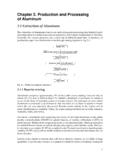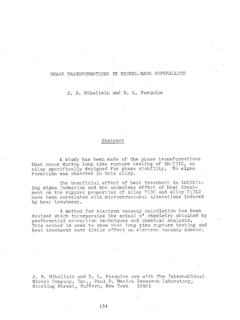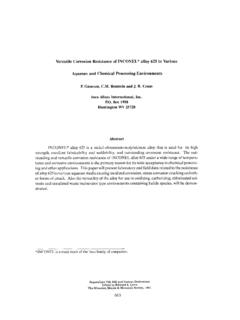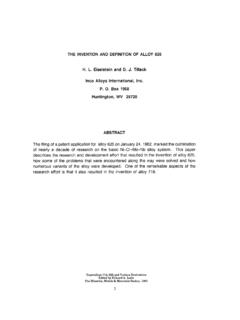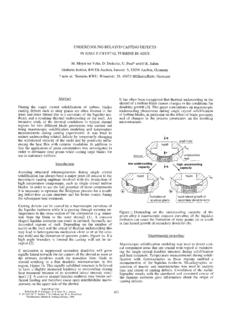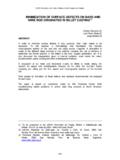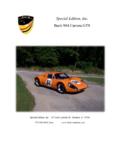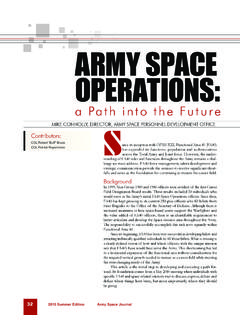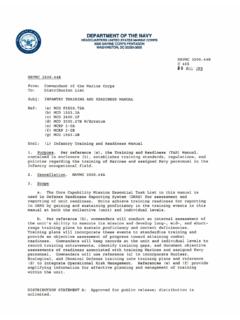Transcription of The Microstructure and Mechanical Properties of …
1 The Microstructure and Mechanical Properties of Inconel 718 Fine Grain Ring Forging Zixing Wang1, Dianhua Zhou1, Qun Deng2, Guosheng Chen1, Wei Xie1 1 Special Steel R & D Center of Special Steel Business Unit, BaoShan Iron & Steel Co., Ltd; Shanghai, 200940, China; 2 High Temperature Materials Research Institute, Central Iron and Steel Research Institute; Beijing, 100081, China Keywords: Inconel 718 alloy, Fine Grains Microstructure , Impact Toughness Abstract The Microstructure and Mechanical Properties of fine-grained Inconel 718 ring forging were investigated in this paper. The results indicated that the fine-grained ring forgings can be obtained by forging the fine-grained Inconel 718 bars.
2 The grain size can be as fine as ASTM 10 and the precipitated phase are spherical. Heat treated at 980 C/1h/water cooling + 620 C /12h/air cooling, the ring forgings possessed very good Mechanical Properties . The impact toughness can be over 100J. In the fatigue test with the stress ratio -1, when the theoretical stress concentration factor is 1 and , the maximum stress for 107 fatigue cycles is over 620 MPa and 260 MPa, respectively. Introduction Inconel 718 alloy has been used world-wide in aerospace, aircraft, oil, and chemical industries, and also nuclear power plants because of its high strength, excellent ductility, good formability and weldability etc [1-3].
3 To meet the demands of different service conditions, the die forging process has been investigated intensively in the past few years. Besides two conventional forging processes, including forging driven by hydraulic presses or hammers, and some advanced forging processes, such as hot die forging, insulation die forging and isothermal forging, have been developed to manufacture fine grains forgings. The products of these processes have been applied significantly in new power units [4-6]. Inconel 718 alloy fine grain ring forgings which were used to manufacture a key part of one new power unit.
4 The part should have excellent impact toughness and high cycle fatigue Properties to meet the complicated cyclic loading seen in service. The Microstructure and Mechanical Properties of fine grain ring forgings have been investigated in this paper. Impact toughness and high cycle fatigue Properties under different stress concentrations were also studied based on the analysis of conventional Mechanical Properties . Material and experimental procedures Trial material was obtained from the Inconel alloy 718 bar by using radial forging machine, the bar was manufactured in Special steel business Unit of Baosteel. The main chemical composition of Inconel 718 trial material is shown in table 1.
5 The melting process of the alloy was VIM+ESR (Ar protected). After homogenization the ESR ingot was forged into octagon bar (220mm) by hydraulic press, then the octagon bar was forged into round bar ( 105mm) by 1300t radial forging machine. The average grain size of the bar is ASTM 7 and 9. 343 Table 1 Chemical composition of Inconel 718 alloy (wt ) C Si Mn S P Cr Ni Mo Nb Ti Al Fe Ring forgings were obtained from the bar stock, which has undergone a process of forge-reheat-forge by using 3000t oil hydraulic press. At the first pass of forging process, the bar stock was heated to 990~1020 C, then forged into pancake and cooled by water immediately.
6 At the second pass of forging, the pancake was heated to 990-1020 C again, and the heat preservation of the billets were by use of applied insulation. The mold was heating to 600-650 C, and the billets were forged into the final shape. The dimensional sketch of ring forging is shown in Figure 1. The heat treatment process was two step treatments consisting of solution treatment at 980 C for 1 hour and water quenched, then reheated to age at 620 C for 12 hours, and then air cooled. Tensile test was conducted on MTS-810 machine; the Charpy-type U notched specimen was used in impact test which carried out on a JB-30 impact machine.
7 Rotary bending fatigue test was conducted on an E4 fatigue machine with a 80-85Hz test frequency and stress ration of -1. Two kinds of samples were chosen for the fatigue test, a smooth specimen and notched specimen with notch radius, the theoretical stress concentration factor is 1 and , respectively. Fig1. A dimensional sketch of ring forging Results and discussion Microstructure of billet and the Ring Forging The Microstructure of 105mm radial forging bar is shown in Figure 2. Typical grain size at center and mid-radius locations of the bar are between ASTM 7 and 9, while the average grain size at bar surface is about ASTM 10, there were also some ASTM 2-4 coarse grains surrounded by ASTM 10 fine grains.
8 In general, fine grain 105mm radial forging bar is beneficial in producing fine grain forgings. 344 (a) Center (b) R/2 (c) Near surface position (d) Coarse grains near surface position Grain structure of 105mm bars shows the Microstructure with phase distribution at different positions of ring forging. It can be seen that phase could be fully spheroidized after the bars were die forged at the critical solution temperature of phase. The average grain size at different positions of ring forgings are estimated to be finer than ASTM 10, Mid-radius to the surface grain size are determined to be uniform and fine.
9 This kind of Microstructure is of great benefit for forging parts to have excellent ductility and high fatigue strength. (a) Near inner surface position (b) Near inner surface position 345 (c) R/2 (d) R/2 (e) Near outer surface position (f) Near outer surface position Fig3. The phase and grain Microstructure of the ring forging The SEM micrograph of phase distribution is shown in Fine phase particles have been observed, and they appear to be spherical in shape. The SEM image of phase Microstructure of ring forging Results presented in literature [7] show that Inconel 718 benefits from hot die forging using die temperature at 900-930 C and billet temperature 990-1020 C for billet when the hot die forging 346 technique is used to forge Inconel 718.
10 If the billet grain size is finer than ASTM 7, then hot die forging under a large deformation ratio can achieve a grain size finer than ASTM 10. In our investigation experiment, heat insulating hot die forging technique is applied, requiring die temperature at 600-650 C. Fine grain forging with the grain size finer than ASTM 10 can be obtained by this route, which greatly reduces the requirement for high temperature capable of die material. This technique can reduce the production costs considerably. Mechanical Properties of the Ring Forging After using the heat treatment designed for this investigation, the forging Mechanical Properties , presented in table 2, and 846-0010 heat number is the typical Inconel 718 forging data.


